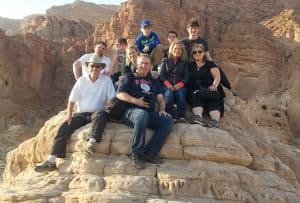

Hello Ofir,
We are back home and catching up on everything that needed to be done. Jane and I both want to thank you so much for the wonderful 3 days of touring. The tours that you gave us were top-notch. I want to particularly thank you for all the help that you gave us with the wheelchair, especially on the last day of our touring with you.
You made touring at extremely crowded tourist sites very enjoyable. I don’t think we could have possibly had better tours of the major sites in Israel, given our time constraints. You made the tours so much fun, and so meaningful. Jane and I both thoroughly enjoyed the Scripture reading at the very historical and religiously significant sites to which you took us.
Thank you again
Charles Thomas, november 2016

Hello Ofir,
Greetings from Oklahoma, USA!
We’ve been back in the states for 7 days adjusting to our central standard
time zone. Our cup runneth over with great memories in Israel. The 3 days
we spent with you are 3 days I will never forget. You more than fulfilled
our dreams for getting our first exposure to your beautiful land, history,
food and people. My friends in Oklahoma now know my fondness for our
fabulous tour guide Ofir. Many thanks for guiding me, Phil, Randy and
Renee’ about Israel. Hope our paths will meet again!!!!
Best to you and your family,
Bonnie Russell

March 28th
Hello Ofir,
It was an amazing experience, going through Israel with your guidance, service , knowledge and care. You really made our trip so special. You navigated us with love and dedication. I know that anyone who has you as a guide, will be as grateful as we are. May g-d continue to blessya special love to the family.
Roth, James and Jonathan Thompson.

June 4th, 2018
Ofir,
Just wanted to thank you again for an excellent two days in Israel. The walking up to masada for the sun rise and the effort that you gave was beyond any expectation.
Jen and I hope to visit again and you can expect an email when the planning begins.
Shalom!
Rob and Jen Shaw

Nov. 29th
Greetings,
Just wanted to drop you a note to let you know that our tour of Israel during the Steps of Paul steps was wonderful. Our little team of 18 people was blessed to be guided by Ofir Horn. It is the first time we have met Ofir and just wanted to let you know that he was very easy to work with.
Ofir made it easy to customize our time in Israel to meet our requirements. He allowed ample time for me to teach from the scriptures and was flexible with our special requests. Ofir was a wealth of information and all the people in our group quickly fell in love with him.
Thanks again.
Looking forward to working with you again on the next trip to Israel!
Phil Evans

March 28th
Hello Ofir,
Thank you so much for the amazing day of touring! Every one enjoyed the day, and blessed me for finding such an excellent guide as you. Thank you for your patient, your incredible knowledge, and for your humor. You definitely caused all of us in thinking about another proper visit in Israel. Hope to meet you again on our next trip to Israel.
Thanks again,
David

